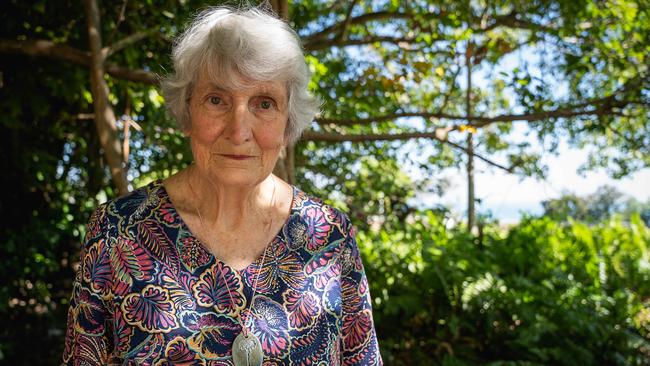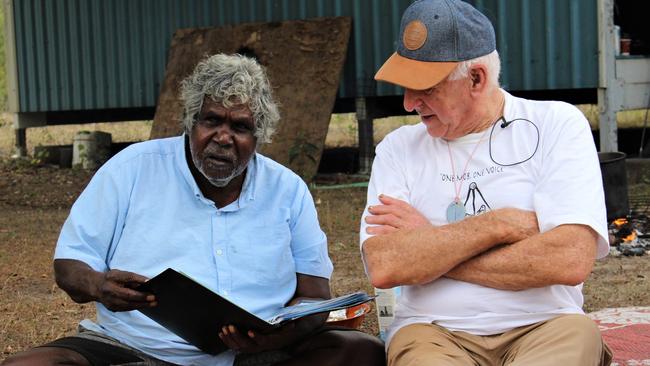Former tidy town’s ghost haunted by mysterious disappearance of Dhakiyarr Wirrpanda
‘They were all busy, everybody was working and it was immaculate’. Read how one of the Territory’s most successful communities went from tidy town to ghost town.

Northern Territory
Don't miss out on the headlines from Northern Territory. Followed categories will be added to My News.
When Djalkiripuyngu cultural leader Dhakiyarr Wirrpanda vanished into the night on November 10, 1934, he left behind a thriving community in the tiny east Arnhem Land outstation of Dhuruputjpi.
Seven decades later when the family of the Territory cop he was acquitted of murdering, Constable Albert McColl, visited the area in 2003, while Dhakiyarr’s family was still feeling the effect of his loss, not all that much had changed.
“They were all busy, everybody was working and it was immaculate,” the wife of Constable McColl’s nephew Alan, Joan McColl says of the community that won multiple NT tidy town awards during that period.
Today, just 20 years later again, Dhuruputjpi is a ghost town, the 40 or so clan members who once thrived there disbursed, their previously bustling homes standing silent in various states of disrepair.
READ PART ONE: Police to probe case of accused cop killer’s mysterious disappearance
READ PART TWO: Family of slain cop call for inquiry into accused killer’s disappearance
Alan McColl, who along with Joan and other McColl family members have been returning to Arnhem Land ever since, says the funding for the running of the community, once “reasonably adequate”, had “gradually disappeared”.
“They were a lot happier (back then),” he said.

“I can’t imagine too many white people would go and live in the same sort of houses that the Aboriginal people are expected to live in.
“Getting maintenance on the houses and what have you out there has been extremely difficult.”
Even a set of solar panels the McColls helped install in 2004 sit idle, “probably coming to the end of their life” now.
“There’s been nothing done to them since we installed them,” Mr McColl said.
“There was a school room built, we were able to supply some power to that but there’s been no upgrade on that system that we put in.”
Traditional custodian of the area, Djambawa Marawili, says there is a direct link between what happened in 1934 when his grandfather was effectively duped into travelling to Darwin to face his accusers and the current situation.
“People need to have a really good facility like in other parts of Australia, housing, maintaining all the things, shops, that way people are still living in homelands,” he said.
“There should be an airstrip, if people get sick there should be a vehicle or ambulance coming to pick up our sick people.
“Then families can be really living in this country.”

Department of Chief Minister and Cabinet regional executive director Jim Rogers is among those tasked with helping the Djalkiripuyngu turn things around through one of several new local decision making agreements.
“That’s the platform in this part of the (Territory) for helping homelands grow and be strong again,” he says.
“It’s an agreement to work towards sustainably living in the homelands, so it provides some funding to help make that happen but it’s also about planning and it’s got some commitments towards housing, essential services, so that people can live safely and healthily in homelands.”
Mr Rogers says the dilapidated housing, electrical and water infrastructure as well as schooling and other services remain “some of the really important questions that we haven’t answered yet”.

“We know some of the families who live in Yilpara, so it’s really about working with them around their timelines when they think they can commit to moving back on a permanent basis and then what sort of support and services they need,” he said.
“So it’s not a timeline that we drive but it’s something that we can work with families on and then make sure the homeland has the right funding to be able to support them to stay on.”
After chatting with Mr Rogers and local leaders in Dhuruputjpi last week, Joan McColl reckons one of the most important topics the group discussed was jobs.
“We all agreed that Yolngu should be doing the jobs, they should be helped to learn to do the jobs,” she said.
“Everywhere you look there’s white people coming in, contractors, instead of the Yolngu people being trained to do it — and then people talk about them sitting around being lazy.”
More Coverage
Originally published as Former tidy town’s ghost haunted by mysterious disappearance of Dhakiyarr Wirrpanda





